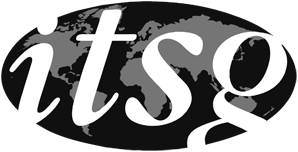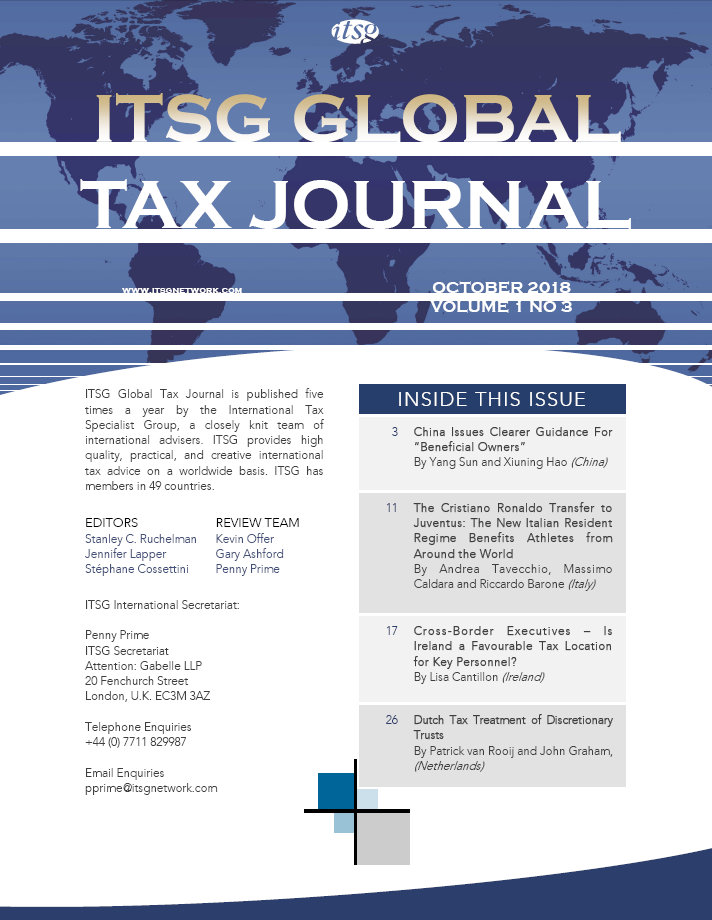Introduction
As a general rule, performance income of resident artists and sportsmen is subject to ordinary personal income tax in Italy (Imposta sule reddito delle persone fisiche or I.R.P.E.F.) on worldwide income. The tax rates are progressive, from 23% up to 43%, plus local surcharges. In addition, income of sportsmen often includes various forms of income from activities considered as “ancillary” to the performance. Here tax treatment is far less clear.
Within this general frame, the Italian Parliament approved the 2017 Budget Law on 7 December 2016, which introduced, inter alia, a new tax regime for individuals who transfer tax residence to Italy (the New Resident Regime). This regime was meant to make the transfer of tax residence to Italy more attractive to wealthy individuals and families. The regime offers preferential tax treatment, which consists of a yearly lump-sum payment of €100,000 on all foreign income and gains and exclusion from inheritance and gift tax on foreign assets. These benefits depart from ordinary treatment of residents under Italian tax law.
In its first year, almost 150 applications were filed. The regime recently made headlines as Cristiano Ronaldo1 moved from Real Madrid to Juventus. Many reporters ascribed this choice to both football reasons and the benefits of Italy’s new fiscal regime.
The wider question is how the flat tax regime can benefit athletes around the world. This article provides a general overview of the New Resident Regime and its effects on sportsmen.
THE NEW RESIDENT REGIME
The New Resident Regime is reserved for individuals who meet the following two conditions:
- They transfer tax residence to Italy.
- They have been nonresident in Italy for tax purposes for nine out of the ten preceding taxable years.
Within this context, it should be noted that art. 2, par. 2 of Presidential Decree 917 of 22 December 1986 (hereinafter, the Income Tax Code or I.T.C.) provides that an individual is deemed to be resident in Italy if any of the following conditions are met on 183 days or more during the tax year (184 or more days in case of leap years):
- The individual is registered in the Civil Registry of the Resident Population.
- The individual is domiciled in Italy pursuant to the Italian Civil Code.
- The individual is resident in Italy pursuant to the Italian Civil Code.
Where any of the conditions outlined above is fulfilled in a calendar year, the individual is deemed to be a resident of Italy for the entire tax period. There are no split-year rules, although exceptions apply for persons arriving from Switzerland and Germany. Where the two requirements are met, an individual may apply for New Resident Regime and take steps to become registered in the Civil Registry of the Resident Population.
Beginning with the 2017 fiscal year, the New Resident Regime provides for lump-sum taxation of €100,000 per year on non-Italian-source income and gains. This payment is in lieu of the tax that would be applied ordinarily. Remittance of the income to Italy has no effect under the New Resident Regime – no additional tax is imposed. Foreign-source income and gains are not subject to income tax whether retained abroad or remitted to Italy. However, all Italian-source income and gains remain subject to ordinary tax rules under the Italian personal income tax regime. The New Resident Regime can be extended to family members by paying an additional €25,000 per year, per relative. The taxpayer may elect to apply the New Resident Regime to income earned in all foreign countries or only selected countries (“cherry picking”). No foreign tax credit is granted for taxes paid in countries for which the new resident has elected to be covered by the €100,000 Italian tax payment.
In addition to the flat tax, the New Resident Regime grants:
- Exemption from reporting obligations in relation to foreign assets (Form R.W.)
- Exemption from payment of wealth taxes on real estate properties and financial assets held abroad (respectively, I.V.I.E. and I.V.A.F.E.)
- Exemption from inheritance and gift tax on rights and assets held abroad
The main aspect to understand is that the lump-sum tax covers only foreign income and gains. Global sportsmen are celebrities with global followings and the effect of the lump-sum tax regime on sportsmen depends on whether income is deemed to be foreign-source income rather than income from Italian sources. To address this exposure area, the New Resident Regime allows for the filing of a ruling request in order to obtain prior approval from the Agenzia delle Entrate on the various types of income that will be covered by the lump-sum payment of €100,000. The ruling request can be filed prior to the establishment of tax residence in Italy.
For these reasons, it is important to analyse the different kinds of income derived by professional sportsmen – and in particular by football players – in order to understand the various benefits a sportsman such as Cristiano Ronaldo might enjoy under this regime.
The balance of this article addresses three key issues for a sportsman:
- Determining the income that is deemed to arise from sports performances for purposes of Italian tax law.
- Determining the income that is deemed to arise the exploitation of image rights for purposes of Italian tax law.
- Determining the source of income for purposes of Italian tax law in order to determine if the income falls within the scope of the New Resident Regime.
Note that concepts of law outside of Italy will affect the overall tax exposure of a sportsman who performs in various countries. The compensation paid to sportsmen for performing typically is taxed in the jurisdiction where the sporting event takes place. Tax rules outside Italy are not considered in this article, much because they are a given no matter which regime applies to a new resident. Similarly, concepts that apply under conventional provisions of Italian tax law are not considered in this article, except to the extent that they do not apply in connection with foreign-source income subject to lump-sum taxation under the New Resident Regime.
QUALIFICATION OF INCOME DERIVED BY SPORTSMAN FROM SPORTS PERFORMANCES
The classification of performance income derived by sportsmen may vary depending on whether a specific contractual obligation exists. Income of sportsmen deriving from their performances can be classified as follows:
- Employment income (art. 49 of the I.T.C.), if the activity is performed under an employment relationship;
- Income assimilated to employment income (art. 50, par. 1, let. c)-bis of the I.T.C.), if the sportsman does not perform his activity in the framework of an employment contract but the professional sportsman falls within the provision of art. 2 of Law n. 91 of 23 March 1981 (hereinafter, Law 91/1981), which deems the income, inter alia, to be that of a sportsman who performs, on a continuous basis, sports activities regulated by the Comitato Olimpico Nazionale Italiano (CONI);
- Self-employment income (art. 53 of the I.T.C.), if the services carried out by the sportsman are deemed to be performed in the framework of an independent service relationship and the conditions set forth by Law 91/1981 are met. In this regard, art. 3, par. 2 of Law 91/1981 provides specific conditions under which the activity of a professional sportsman should be included in the framework of an independent relationship.
¡ The activity is performed during a single sports event, which lasts for a short period of time;
¡ The sportsman has no contractual obligation to participate on a continuous basis in preparatory and training meetings; and
¡ The sportsman’s activities do not exceed eight hours per week, five days per month, or 30 days within a one-year period.
As an example, the activity performed by a football player is deemed to be considered as employment income because the player has a contractual obligation with the football club and the services are carried out under an employment relationship. In comparison, income derived by a professional golfer falls within the category of self-employment income as the activity performed is not deemed to be carried out in the framework of a dependent service relationship and such sportsman does not belong to a federation that is part of the CONI.
ANCILLARY ACTIVITIES TO PERFORMANCE
In addition to the income deriving from the activity performed, the income of sportsmen often includes casual income from activities considered as “ancillary” to the performance of services as a sportsman. Examples include income derived from the exploitation of image rights from sponsorship, advertising and endorsement. This income must be analysed and classified in order to understand the right tax treatment.
Image rights are generally divided into two broad categories. The first category is advertising/marketing activities. The second category is sponsoring activities. The dividing line between advertising/marketing and sponsoring activities is somewhat blurred. In general, advertising/marketing income often refers to “off-court” activities that are not directly related to the performances of services as a sportsman. An example is participation in television or print advertising campaign. In comparison, sponsorship generally refers to financial support in the form of products or services given by the sponsoring company or an institution to the person being sponsored pursuant to the terms of a contract of sponsorship. The sponsorship contract is reciprocal in that the sponsor provides funding and the sportsman wears clothing with the sponsor’s logo or uses its equipment when providing services as a sportsman. The expectation of the sponsor is brand enhancement from image advertising. Sponsorship income generally requires the active participation of the sportsman, endorsing a specific product, often using the product in competition and allowing the sportsman’s image to be associated with the product. Think of a professional golfer wearing a golf cap carrying the logo of a brand of golf clubs. The cap with the logo never comes off while playing, in press interviews, or at public appearances.
INCOME DERIVED FROM THE EXPLOITATION OF IMAGING RIGHTS: SPONSORSHIP AND ADVERTISING/MARKETING
Qualifying the income from the exploitation of image rights is not straightforward under Italian law. From a civil law perspective, image rights are personal rights with patrimonial substance and are included within the class of “rights connected to the exploitation of copyright” in accordance with Law 633 of 22 of April 1941. From a tax perspective, no specific rules have been established within Italian law and views vary. Some authors hold the view that income derived from the personal exploitation of image rights directly by the sportsman should be classified as “other income” under art. 67 of the I.T.C. and, in particular, as income derived from the assumption of an obligation to act, to abstain from acting, or to permit the action of another (obbligo di fare, non fare o permettere) under art. 67, par. 1, let. l) of the I.T.C. Other authors hold the view that such income should be classified as self-employment income.
The position is different in the case of sale or assignment of such rights to the club or to a foreign entity such as a “star company”. As a general rule, any remuneration paid by the club to the player in the framework of the employment relationship is considered employment income and taxed accordingly under art. 49 of the I.T.C. Therefore, if the image right is assigned to the employer by the football player, any income deriving from the assignment is deemed to be considered as employment income and taxed as such. It is of no consequence that the payment is not related to a sports performance or that the payment refers to the exploitation of the personal image of the player. Payments by an employer are treated as employment income. Hence, such income will be subject to I.R.P.E.F. in the hands of the football player with the application of progressive tax rates from 23% up to 43%, plus local surcharges. Moreover, income paid to Italian football players is subject to withholding tax according to art. 23 of Presidential Decree 600/1973 at applicable rates.
At times, the exploitation of image rights is carried on through a foreign entity without a permanent establishment in Italy. This company is sometimes referred to as a “star company” and the star performer is the principal shareholder. Income received by the sportsman from star company in the form of a dividend should be foreign-source income pursuant to art. 23, par. 1, let. b). However, the answer is not entirely clear.
Many anti-avoidance provisions exist in Italian tax law that can be used by tax authorities to attack foreign structures set up to circumvent Italian taxation.
- Art. 23, par. 2, let. d) of the I.T.C., which provides that when income paid to a foreign entity refers to a sports performance event carried on in Italy, the income is taxable as if it were earned directly by the resident sportsman.
- If the company is located in a low tax jurisdiction, art. 167 of the I.T.C. related to controlled foreign companies (C.F.C.s) applies. It states that if the player controls the foreign entity and certain other conditions are met, the income of the C.F.C. is imputed to the Italian resident player under a “look through” approach2.
- If the foreign entity is considered as a fictitiously interposed entity, any income of the foreign entity is ascribed to the player. In other words, the entity is totally disregarded.
THE NEW RESIDENT REGIME AND ITS EFFECTS ON SPORTSMEN
The foregoing rules affect the scope of benefits that can be obtained under the New Resident Regime when the taxpayer is a sportsman.
Income from performances carried out by football players is classified as employment income. Through a so-called “mirror image” of art. 23, par. 1, let. c) of the I.T.C., employment income is deemed to be foreign-source income if the activity is performed abroad. If the services are performed in Italy, the income is deemed to have its source in Italy. Hence, the salary paid by Juventus to Cristiano Ronaldo for participating in Serie A football matches is Italian-source income. Therefore, the salary is not within the scope of the New Residents Regime and is subject to I.R.P.E.F. On the other hand, if Juventus pays a bonus to Cristiano Ronaldo for a victory in the Champions League final and the game is played in Belgium, arguably the income is foreign-source income considering that the performance is carried on abroad. It follows that income should be covered by the lump-sum tax of €100,000.3 Of course, tax exposure can exist in the country where the match takes place, and that tax will not give rise to a foreign tax credit against Italian taxes unless Ronaldo elects to include the income in the regular tax regime.
Income from image rights is employment income if it is directly or indirectly paid by the employer in the framework of the employment relationship. Therefore, if Ronaldo should assign his image rights to Juventus in connection with a football match, any income paid by the club would be treated as employment income from an Italian tax perspective. Because the main activity is performed in Italy, income derived would be subject to ordinary taxation. In principle, considering that many U.E.F.A. matches take place away from Italy, it might be possible to apportion the image right income based on the location of games played in the course of the year. In practice, apportionment is not really possible in Italy.
In the case of direct exploitation of image rights by a sportsman, the income derived may be classified as “other income” or “self-employment income”. The sponsorship income linked to a sports performance – such as revenue from a sponsorship contract that requires Ronaldo to wear a specific cleat while playing in football matches – should fall within the “other income” classification (obligation to do) and therefore should be deemed to be sourced in Italy under art. 23, par. 1, let. f) of the I.T.C. when the relevant activity is performed on the Italian territory. On the other hand, if a specific contract requires Ronaldo to wear something only in Champions League matches performed abroad, the income derived by Ronaldo for wearing the cleats in the rest of Europe should be foreign-source income and therefore covered by the New Residents Regime. Again, tax likely will be imposed in each country where a match is held.
When the exploitation of image rights is not directly linked to a sports performance, it might be difficult to determine where the activity is performed. A typical example is represented by a contract for a sportsman shown drinking a specific brand of beverage in a media campaign. In this case, the parameters are not clear in terms of identifying the source of the revenue. Is the payment received for a service, in which case, the place where the shooting takes place should control the source of income or is it paid for use of the image in the market where the advertisements are displayed? An official clarification by the Tax Authorities is desirable as the rules are not clear.
Another image right example relates to the exploitation of a personal brand licensed to unrelated companies. In the case of Ronaldo, the personal brand the CR7 brand. In such case, considering that the exploitation of his own brand is carried out on a continuous basis and represents an activity not linked to performance, the income should be classified as income derived from the exploitation of intangible assets by the “author”4, which is a form of self-employment income. For instance, the royalties paid by a French fragrance company for the use of CR7 brand should be considered as a foreign-source income5 and therefore covered by the lump-sum tax regime, if the advertising campaign is carried on in European countries other than Italy.
Different considerations apply to the exploitation of image rights through a foreign star company controlled by the sportsman. Under general principles, the dividend paid to the sportsman/shareholder is foreign-source income and therefore covered by the New Resident Regime. Circular Letter 17/E/20176 provides favourable treatment for these payments in order to attract nonresident sportsmen and others to Italy. It provides that, if the income of the star company is genuinely sourced abroad, the lump-sum taxation regime applies, even if the entity is disregarded from a fiscal perspective. In addition, if the sportsperson elects the New Resident Regime, the Italian C.F.C. rules should not apply.
CONCLUSIONS
In principle, when a sportsman such as Ronaldo establishes residence in Italy and elects the New Resident Regime, attractive benefits may be obtainable regarding various types of income. These include bonuses for participation in U.E.F.A. final matches abroad and revenue derived from the use of image rights abroad. But as the New Resident Regime has been in place for only one year and Italian tax law applicable to employees and independent contractors is relatively complex, some degree of uncertainty exists as to the source of the income and the benefits that are obtainable.
The situation may be different for athletes involved in other sports, especially for those with activities in several different countries, who receive income from activities mainly performed outside Italy. Included are golfers, tennis players, Formula 1 racing drivers and boxers, all of whom are treated as independent contractors deriving self-employment income. These persons may find the New Resident Regime helpful.
No uncertainty exists with regard to income arising from investments held abroad. Income derived from such assets are foreign-source income and therefore covered by the lump-sum tax regime. The rules favour such investments by allowing the income to be remitted on a tax-free basis to Italy and by excluding the foreign assets from inheritance tax.
1 Mr. Ronaldo has recently been the subject of allegations of sexual misconduct. This article should not be seen as condoning such behaviour. If you or someone you know has been a victim, resources are available. See RCNE’s Sources of help for survivors.
2 When the company is located in a low-tax jurisdiction but the C.F.C. rules do not apply, the dividend paid to the shareholder is subject to progressive tax rates from 23% up to 43% instead of a flat rate equal to 26%.
3 In order to provide a general framework, in case of self-employment income the income from performances is deemed to be a foreign-source income if the activity is performed outside Italy. Hence, the golf player who earns a prize money for a tournament won abroad will be covered by the lump-sum regime. On the other hand, in case of income assimilated to employment income, such income is to be considered as Italian-situs income if such income is paid for the performance of services in Italy. Therefore, the professional cyclist who transfers his residence to Italy to join an Italian-resident cycling team should not benefit from the new resident regime with reference to the salary paid by his Italian team.
4 See art. 53, par. 2, let. b) of the I.T.C.
5 See art. 23, par. 2, let. c) of the I.T.C.
6 It has been clarified that where an individual benefiting from the New Resident Regime is a director in a company formed outside of Italy, the entity is not considered to be tax resident in Italy, provided that the majority of the board of directors are not Italian residents.

 Login
Login





















































